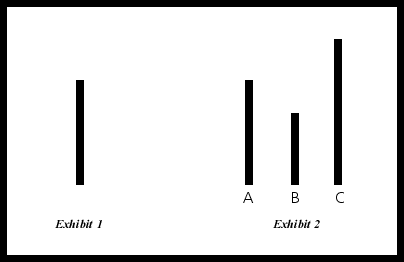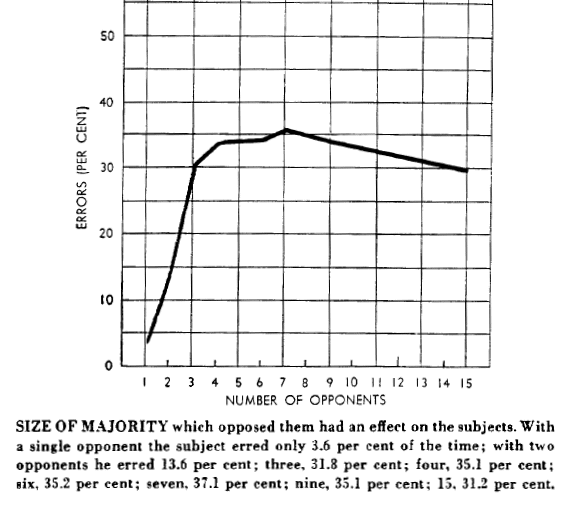
Source
Asch, S. E., Effects of Group Pressure Upon the Modification and Distortion of Judgements. In H. Guetzkow (ed.) Groups, Leadership, and Men, 1951.This is a summary of the famous Asch experiment where subjects were placed with a group of confederates who gave different measurements of a line than was reality. Asch measured whether the subject would modify their interpretation based on the majority opinion.
The test objective was to study "the social and personal conditions that induce individuals to resit or to yield to group pressures when the latter are perceived to be contrary to fact.
A group of eight individuals (one subject and seven confederates) sat in a room and verbally stated which of three unequal lines matched a given line. The subject was seated so that he made his verbal judgement last. In most cases the confederates and subject agreed, but in certain cases the confederates all agreed on a wrong answer.
The "majority effect" was measured as the % of responses that erroneously conformed to the majority. They also tried to ascertain whether the subject was aware of the majority effect on him and why they acceded to group opinion. They also watched the reaction of the subject when the experiment was revealed. All subjects and confederates were male college students.
Initial Results
About one third of the responses conformed to the erroneous majority (compared to almost no errors in the control group). Some subjects always defied the group, some always went along with them. 25% were completely independent, 33% were more than half with the erroneous majority. Some were completely confident throughout, some were disoriented and confused.
The independent subjects were categorized as 1) confident in their differences 2)withdrawn and 3)considerable tension and doubt, but adhere to their views
The yielding subjects could be categorized as 1)distorted perception who believed the majority estimates as correct 2)distortionof judgement -- they believe their own perceptions are inaccurate (they have primary doubt and lack of confidence). 3)Distortion of action -- they believe the group is wrong but conform to avoid being different.
Experimental Variations
The effect of "ununanimous" majorities
In one variation, they added one more subject at position 4. This reduced the % of errors from 32% to 10%. In another variation, having one confederate give right answers throughout reduced it to 5.5%.
This shows that even a minimal amount of dissenting support is enough to give people confidence in their opinions against the majority. The researchers found that even a unanimous majority of only three is better than 8 with one dissenter.
The effect of withdrawal of a "true partner"
Surprisingly, if a confederate who was answering correctly "defects" back to the majority halfway through, the % of with-the-majority responses returns from 5.5 to 28.5%.
The effect of late arrival of a "true partner".
If a confederate answering with the majority changes to answering truly, the rate of majority response drops down to 8.5%.
The effect of a "compromise partner" (who answered with majority sometimes, correctly sometimes).
This reduced the rate of majority response but not significantly.
The effect of majority size.
They varied the number of confederates from 1,2,3,4,8, and 10-15 persons. There was no majority effect with only one other person. There was a small change with two people, and nearly the full amount with three confederates. There was little change above three confederates.
Interestingly, in one condition they put 16 naive persons in a room and had two confedrates give wrong answers. The group responded with amusement at their errors.
They also found that the degree of independence increases with the deviation of the majority from the truth. However, even big differenes didn't create complete independence. They also concur with other researchers that the effect of majority opinion increases with decreased clarity in a situation.

No comments:
Post a Comment
Note: Only a member of this blog may post a comment.